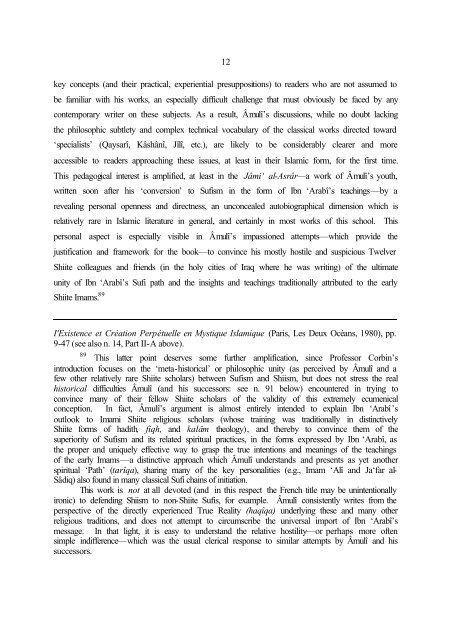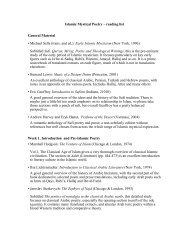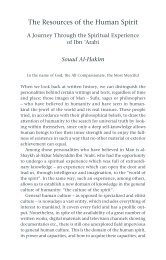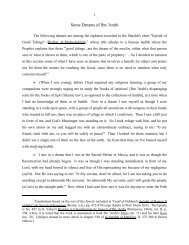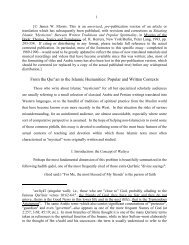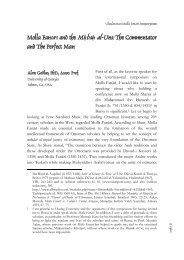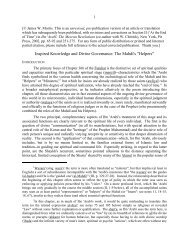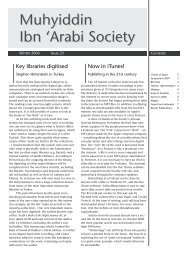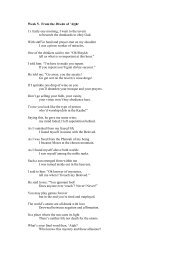Part III (pdf) - Muhyiddin Ibn Arabi Society
Part III (pdf) - Muhyiddin Ibn Arabi Society
Part III (pdf) - Muhyiddin Ibn Arabi Society
You also want an ePaper? Increase the reach of your titles
YUMPU automatically turns print PDFs into web optimized ePapers that Google loves.
12key concepts (and their practical, experiential presuppositions) to readers who are not assumed tobe familiar with his works, an especially difficult challenge that must obviously be faced by anycontemporary writer on these subjects. As a result, Âmulî’s discussions, while no doubt lackingthe philosophic subtlety and complex technical vocabulary of the classical works directed toward‘specialists’ (Qaysarî, Kâshânî, Jîlî, etc.), are likely to be considerably clearer and moreaccessible to readers approaching these issues, at least in their Islamic form, for the first time.This pedagogical interest is amplified, at least in the Jâmi‘ al-Asrâr—a work of Âmulî’s youth,written soon after his ‘conversion’ to Sufism in the form of <strong>Ibn</strong> ‘Arabî’s teachings—by arevealing personal openness and directness, an unconcealed autobiographical dimension which isrelatively rare in Islamic literature in general, and certainly in most works of this school. Thispersonal aspect is especially visible in Âmulî’s impassioned attempts—which provide thejustification and framework for the book—to convince his mostly hostile and suspicious TwelverShiite colleagues and friends (in the holy cities of Iraq where he was writing) of the ultimateunity of <strong>Ibn</strong> ‘Arabî’s Sufi path and the insights and teachings traditionally attributed to the earlyShiite Imams. 89I'Existence et Création Perpétuelle en Mystique Islamique (Paris, Les Deux Océans, 1980), pp.9-47 (see also n. 14, <strong>Part</strong> II-A above).89This latter point deserves some further amplification, since Professor Corbin’sintroduction focuses on the ‘meta-historical’ or philosophic unity (as perceived by Âmulî and afew other relatively rare Shiite scholars) between Sufism and Shiism, but does not stress the realhistorical difficulties Âmulî (and his successors: see n. 91 below) encountered in trying toconvince many of their fellow Shiite scholars of the validity of this extremely ecumenicalconception. In fact, Âmulî’s argument is almost entirely intended to explain <strong>Ibn</strong> ‘Arabî’soutlook to Imami Shiite religious scholars (whose training was traditionally in distinctivelyShiite forms of hadith, fiqh, and kalâm theology), and thereby to convince them of thesuperiority of Sufism and its related spiritual practices, in the forms expressed by <strong>Ibn</strong> ‘Arabî, asthe proper and uniquely effective way to grasp the true intentions and meanings of the teachingsof the early Imams—a distinctive approach which Âmulî understands and presents as yet anotherspiritual ‘Path’ (tarîqa), sharing many of the key personalities (e.g., Imam ‘Alî and Ja‘far al-Sâdiq) also found in many classical Sufi chains of initiation.This work is not at all devoted (and in this respect the French title may be unintentionallyironic) to defending Shiism to non-Shiite Sufis, for example. Âmulî consistently writes from theperspective of the directly experienced True Reality (haqîqa) underlying these and many otherreligious traditions, and does not attempt to circumscribe the universal import of <strong>Ibn</strong> ‘Arabî’smessage. In that light, it is easy to understand the relative hostility—or perhaps more oftensimple indifference—which was the usual clerical response to similar attempts by Âmulî and hissuccessors.


